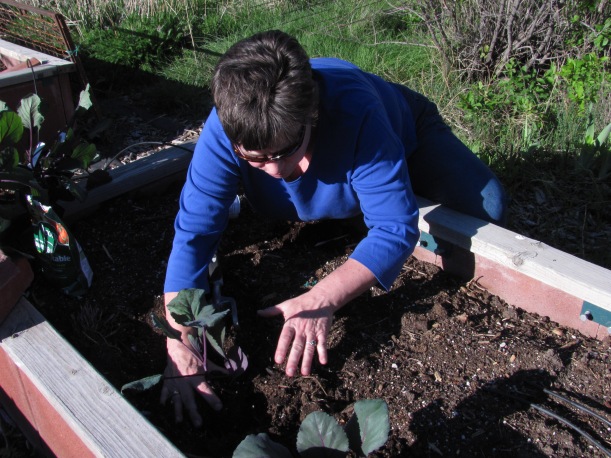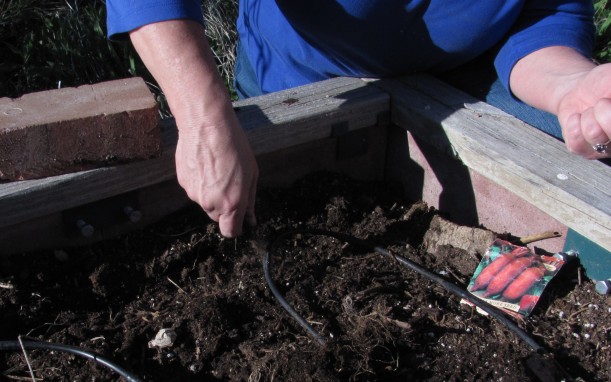
Laramie County Master Gardener Kathy Shreve prepares a trench for seeds in a raised bed set up with soaker hoses. Photo by Barb Gorges.
Published in the Wyoming Tribune Eagle June 4, 2017, “Time to get your garden growing.”
By Barb Gorges
I spent a recent evening in the garden with Kathy Shreve, Laramie County master gardener, reviewing what to know about local vegetable gardening. The topics mentioned here are covered in greater depth in the “gardening” section of the Cheyenne Botanic Gardens website, http://botanic.org, which also has the link to the archive of my previous columns.
Timing
Wait until the end of May or later to transplant tender veggies like tomatoes, eggplants, cucumbers or put them under a season-extending cover like a low tunnel. You can also plant them in containers you can scoot in and out of the garage.
However, Shreve started cabbage and onion plants indoors and planted them before the snow May 18-19 and they were fine. Some vegetables, like members of the cabbage family, don’t mind cold as much.
While peas, cabbage types, lettuces and other greens, can be planted earlier than the end of May, most vegetable seeds planted directly in the garden prefer warmer soil temperatures. Measure with a soil thermometer found at garden centers.
Shreve said we can plant as late as June 20. Plant fast growing crops as late as July if you want a fall harvest.
Location
Keep in mind the vegetable garden needs a minimum of six hours of sun per day, preferably morning sun.

Shreve transplants cabbages she started indoors. Photo by Barb Gorges.
Transplants
Because of our short growing season, tomatoes and other tender vegetables are started indoors. Always look for the short season varieties of these plants. Shreve said she looks for 80 or fewer “days to maturity.”
If the plant was not outside when you bought it, it will need hardening off. Start with the plant in the shade for two or three hours and day by day increase the amount of sun and the length of exposure by a couple hours. Keep it well watered.
When transplanting, Shreve advises digging a hole for your plant, filling it with water, then letting it drain before planting.
To remove a plant from a plastic pot, turn it upside down with the stem between your forefinger and middle finger. Squeeze the pot to loosen the soil and shake it very, very gently.
If there are a lot of roots, you can gently tease them apart a bit before putting the plant in the hole.
Hold the plant by the root mass so that it will sit in the hole with the soil at the same level of the stem as it was in the pot. Fill soil in around the roots, then tamp the soil gently.
However, tomatoes can be planted deeper since any part of their stem that is underground will sprout roots, the more the better. In fact, Shreve said to pinch off all but three or four leaves and bury the bare stem.
Lastly, keep plants well-watered, not soggy, while they get established. Wait a couple weeks before adding fertilizer to avoid burning the plants.
Mulch
Shreve mulches with certified weed-free straw available at local feed stores, but grass clippings and last year’s leaves can also be used.
Placing mulch 2 to 3 inches deep keeps the soil from drying so fast, shades out weeds and keeps rain and overhead watering from spattering dirt onto plants, which may spread disease. It can also keep hail from bouncing and inflicting damage twice.

Seed
Root crops, like carrots and beets, don’t transplant well, so you are better off starting them from seed.
While fresh is good, Shreve said she’s had luck with seed seven years old. But the germination rate isn’t going to be great. She might spread carrot seed a little more thickly if that was the case, and it’s easy to thin to the proper spacing (and the thinnings can be tasty).
Because Cheyenne is dry, Shreve plants in a little trench. That way, when moisture comes, it will collect down where the plants are.
Seed packets tell you how deep to plant. The rule of thumb is three to four times deeper than the breadth of the seed. Lay the seed in the bottom of the trench and sprinkle that much dirt on them. Then water well, but gently, so you don’t wash out the seeds. Keep the soil surface moist until the seeds germinate.
Lightly mulch when the seedlings are visible, adding more as the plants get bigger.
Mark rows with popsicle sticks or plastic knives left from picnics.
Water
Once plants are established, let the top 1-2 inches of soil dry out between waterings. Test by sticking your finger in the soil. Water deeply.
Shreve waters every other day using soaker hose and drip irrigation systems, except when it rains. She originally tested her system for 30 minutes to see if water made it to the root depth and decided on 40 minutes.
Water in the morning, or at least make sure leaves are dry before dark.
Bugs and weeds
Mulch should eliminate most of the need to weed. Shreve said to keep up with it—it’s easier to pluck weed seedlings than to have them establish deep roots and go to seed.
For bugs, Shreve said it is easy to Google “what insect is eating my cabbage,” or take the critter, or evidence, to the Laramie County Extension horticulturist, Catherine Wissner. Her office is now out at Laramie County Community College, fourth floor of the new Pathfinder Building.
Never use pesticides until you identify your problem, and then try the least toxic method first. Again, more is not better. Never apply more than the directions indicate.
Slugs—my nemesis—indicate a garden is too wet.
Shreve said to roll newspaper to make 1 to 2-inch-diameter tunnels. Place rolls around affected plants in the evening. By sunrise, the slugs will be inside the rolls to get away from the light and you can dispose of them, rolls and all.
Fertilizer
Never add wood ash or lime to our alkaline soils as those work only on eastern, acidic soils.
Shreve likes slow-release products which are less likely to burn the plants, as are the natural fertilizers. Additionally, compost tea is a good soil conditioner.
Again, more is not better. Shreve uses half of what is directed until she sees how the plants respond.
Over-fertilization of fruit-producing vegetables like tomatoes often keeps them from producing the flowers that become the fruit. Shreve said they need to be stressed a little bit because it gets them thinking about preservation of the species and producing seed, rather than just enjoying life and producing leaves.
“Just leaves” is OK if you are growing leafy vegetables like lettuce, kale, spinach and chard.
Trellis and cage
If you are growing vining vegetables, getting them off the ground means fruits stay cleaner and don’t rot, and they are easier to find and pick. Use old chain link gates, bed springs, or anything else—be creative.
Hog panels make sturdy tomato cages 5 feet high and 2.5 feet in diameter for larger, indeterminate varieties, with chicken wire over the top for hail protection. Otherwise, use jute twine to loosely tie the stem to a bamboo stake.
Add flowers
Adding annual flowers like alyssum, marigolds and sunflowers, or herbs including dill and oregano, attracts pollinators and beneficial insects to your garden.
